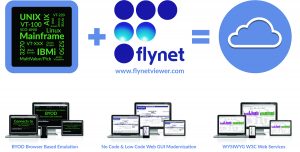The combination of continually evolving customer desires with ever-accelerating technology innovation is driving enterprises into a digital transformation frenzy. Transform or die is now the mantra, Innovator’s Dilemma be damned!
It seems that every bank, insurance carrier, manufacturer, and telecom wants to be the next Facebook or Netflix of their industry – leveraging massive scale, blistering speed, and billions of customers who can’t seem to get enough of anything.
If only it weren’t for the massive boat anchor that threatens to hold every large organization back: legacy.
Legacy technologies to be sure, but also legacy processes, legacy organizational models, and worst of all, legacy ways of thinking. How is an enterprise to compete?
The Three Legacy Options
What to do about the legacy problem has been a perennial question for CIOs for decades. What’s different now is the sense of urgency and importance, as the risk of not doing something about legacy exceeds any risks inherent in finally dealing with the problem.
Not everyone agrees. Gartner’s Bimodal IT advice, for example, is for its clients to leave legacy alone – allowing traditional IT to continue to follow slow, old fashioned processes and policies while the separate digital organization follows modern, rapid approaches.
However, CIOs are rapidly picking up on the flaws in Gartner’s advice, realizing that they must do something to transform their existing IT shop. Organizations, therefore, are taking the “leave it alone and hope for the best” option for their legacy technologies off the table.
Nevertheless, the proper course of action is far from straightforward, as it depends upon the unique priorities of the organization as well as the particular technologies in place. Instead, the options facing IT leadership tend to fall into three general categories: reuse, rewrite, and replace.
The reuse option goes well beyond leaving older technologies alone, as digital transformation drives new uses for existing technologies, which now become the old dogs responsible for learning new, digital tricks.
Sometimes, however, legacy assets cannot support new requirements as-is. Frequently, the best option is to make changes to legacy applications themselves, rewriting them where necessary.
Clearly, though, rewriting older code isn’t always possible. In many cases source code and documentation are long gone, as are the original developers of the applications. When rewriting such applications is impossible and reuse is also impractical, replacing legacy technology may be the only remaining option.
Making the Right Choice
Replacing older systems, however, is never a choice a CIO should make lightly, as it can be expensive, time consuming, and risky. All too often, younger CIOs with digital mandates take one glance at legacy technology and jump to the conclusion that replacement is the best option – when in many cases, reuse or rewrite is lower cost and lower risk.
To avoid this mistake, IT leadership must get up to speed on the modern tools and technologies for making the right choice regarding its legacy assets. Yet while many tool vendors for legacy systems are themselves slow moving and inflexible, there are notable exceptions.
One such example is Flynet. Flynet’s core offering is terminal emulation software for a range of ‘green screen’ systems, including mainframes, midrange systems, and older Unix environments.
Terminal emulation has been around for years, of course, but Flynet’s tools are fully modern, and can be instrumental for helping organizations make the appropriate choice among reuse, rewrite or replace.
Flynet’s terminal emulation, in fact, supports the enable part of its three-pronged strategy: enable, enhance, and evolve.
 To enable, the Flynet Viewer TE (terminal emulation) runs in any browser on any form factor device, bringing legacy interactions to modern digital touchpoints.
To enable, the Flynet Viewer TE (terminal emulation) runs in any browser on any form factor device, bringing legacy interactions to modern digital touchpoints.
To enhance, Flynet also offers Flynet Viewer Studio UX (user experience), a web modernization platform that takes a low-code/no-code approach, converting green screens into web pages that once again support any browser on any device.
In addition, Flynet Viewer Studio UX doesn’t require Java support on the browser, an essential requirement now that Oracle has deprecated browser-based Java.
For evolve, the Flynet Viewer Studio WS (web service) can expose legacy assets as SOAP (XML) or RESTful (JSON or XML) Web Services, useful today for connecting legacy assets to middleware, both on premises as well as to a variety of cloud-based integration-as-a-service offerings.
Given the breath of capabilities Flynet brings to companies with legacy green-screen systems, the decision to replace such systems is no longer such an obvious choice. However, at some point in time, replacement will eventually become the right decision.
Flynet Viewer Studio WS can also aid in this transition as well, as it’s often possible to reimplement legacy-based Web Services with whatever system replaces the legacy asset.
The Intellyx Take
Whenever an organization must make the decision whether to reuse, rewrite, and replace a legacy asset, the most important principle to follow is to choose the right tool for the job.
True, sometimes the right tool is something new – but for many of the tasks that legacy systems have been handling for years, maintaining and possibly updating those systems is the better alternative.
Just because such systems and the applications running on them might be old, that doesn’t mean that there aren’t modern tools that can bring legacy assets into the digital age. Flynet offers such tools, giving its customers better ways of reusing legacy assets, rewriting their user interfaces, or exposing their capabilities as Web Services for incorporation into modern, distributed applications.
Copyright © Intellyx LLC. Flynet is an Intellyx client. At the time of writing, none of the other organizations mentioned in this paper are Intellyx clients. Intellyx retains full editorial control over the content of this paper. Image credit: Flynet.



